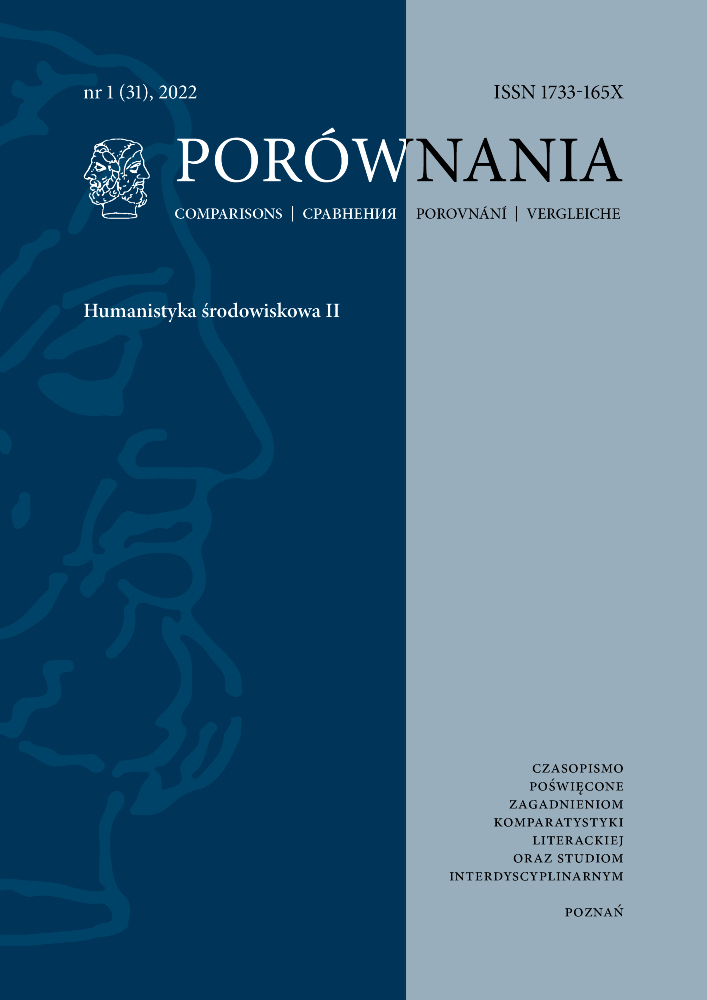Abstract
In the novel River published in 2014, while wandering along the River Lea on the outskirts of London, the narrator observes an inconspicuous area that does not correspond to the traditional notion of the beauty of nature. The contemplation of the landscape finds its artistic expression not only in language that is not only extremely precise but also lyrical. The exploration of nature is also accomplished through the creative act of naming and describing the human and non-human world. Kinsky depicts a variety of landscapes: the area around the river with its mixture of nature and industry, urban and rural character, other riverine landscapes from the perspective of memories, and areas marked by war and violence. The subject’s attitude is characterized by resignation from an anthropocentric perspective that instrumentalizes nature. The aim of the article is to examine the mutual relations between the human being and the environment in the literary text, including the ecocritical perspective, as well as to investigate the aesthetic representation of landscape and nature in the novel.
References
Böhme Gernot, Atmosphäre (sensu Gernot Böhme) 2019, in: Online Encyklopedia Philosophy of Nature / Online Lexikon Naturphilosophie, hrsg. von Thomas Kirchhoff, 2019, https://tinyurl.com/4dwrv562 [Zugriff: 9.05.2022].
Ders., Für eine ökologische Naturästhetik. Suhrkamp, Frankfurt am Main 1989.
Ders., Leib. Die Natur, die wir selbst sind. Suhrkamp, Frankfurt am Main 2019.
Ders., Natürlich Natur. Über Natur im Zeitalter ihrer technischen Reproduzierbarkeit. Suhrkamp, Frankfurt am Main 1992.
Braidotti Rosa, Jenseits des Menschen: Posthumanismus, "Bundeszentrale für politische Bildung", 9.09.2016, https://tinyurl.com/23pjpybh [Zugriff: 9.05.2022].
Buell Lawrence, Thoreau i środowisko naturalne. Ins Polnische übersetzt von Kaja Gucio, "Literatura na świecie" 2020, nr 9-10, S. 305-330.
Debord Guy, Introduction à une critique de la géographie urbaine, "Les lèvres nues" 1955, N˚ 6. Bruxelles.
Kinsky Esther, Fremdsprechen. Gedanken zum Übersetzen, Matthes & Seitz, Berlin 2013.
Dies., Am Fluß, Matthes & Seitz, Berlin 2014.
Dies., Nature Writing. Esther Kinsky im Gespräch mit Katharina Teutsch, Deutschlandfunk, 28.01.2020, https://tinyurl.com/33y96r3b [Zugriff 9.05.2022].
Kittstein Ulrich, Deutsche Naturlyrik. Ihre Geschichte in Einzelanalysen, Wissenschaftliche Buchgesellschaft, Darmstadt 2012.
Rodaway Paul, Sensuous Geography. Body, Sense and Place, Routledge, London 2002. DOI: https://doi.org/10.4324/9780203082546
Sommerfeld Beate, "Die sprachlosen Räume dazwischen" - Olga Tokarczuks und Esther Kinskys Pilgerfahrten durch Europa, in: Polen und Deutsche in Europa. Beiträge zur internationalen Konferenz, hrsg. von Krzysztof Trybuś, Michael Düring u. Maciej Junkiert. Peter Lang, Berlin 2018, S. 109-130.
Störig Hans-Joachim, Kleine Weltgeschichte der Philosophie, Suhrkamp, Frankfurt am Main 1999.
Struck Lothar, Vom Heimischwerden im Spazierengehen. Esther Kinsky erzählt von ihren Wanderungen "Am Fluß", http://www.glanzundelend.de/Artikel/abc/k/esther-kinsky-am-fluss.htm. [Zugriff 9.05.2022].
Weiland Marc, Topografische Leerstellen, in: Topografische Leerstellen. Ästhetisierungen verschwindender und verschwundener Dörfer und Landschaften, hrsg. von Martin Ehrler u. Marc Weiland, Transcript, Bielefeld 2018, S. 11-49. DOI: https://doi.org/10.1515/9783839440513-002
License
Utwory opublikowane w czasopiśmie „Porównania”, na platformie Pressto należącej do Uniwersytetu im. Adama Mickiewicza w Poznaniu są udostępniane na licencji Creative Commons Uznanie autorstwa - Bez utworów zależnych 4.0 Międzynarodowe (CC BY-ND 4.0)
Tym samym wszyscy zainteresowani są uprawnieni do korzystania z utworów opublikowanych pod następującymi warunkami:
-
uznania autorstwa — czyli obowiązek podania wraz z rozpowszechnianym utworem informacji o autorstwie, tytule, źródle (odnośniki do oryginalnego utworu, doi) oraz samej licencji
-
bez utworów zależnych — remiksując, przetwarzając lub tworząc na podstawie utworu, nie wolno rozpowszechniać zmodyfikowanych treści.
-
brak dodatkowych ograniczeń — nie można korzystać ze środków prawnych lub technologicznych, które ograniczają innych w korzystaniu z utworu na warunkach określonych w licencji.
Uniwersytet im. Adama Mickiewicza w Poznaniu zachowuje prawo do czasopisma jako całości (układ, forma graficzna, tytuł, projekt okładki, logo itp.).
Autor zachowuje prawa majątkowe, ale udziela zgody Uniwersytetowi im. Adama Mickiewicza w Poznaniu na wykorzystanie dzieła. Autorzy tekstów zakwalifikowanych do publikacji proszeni są o wypełnienie podpisanie i przesłanie umowa (PL) agreement (EN)
Agreement for granting a royalty-free license to works with a commitment to grant a CC sub-license





